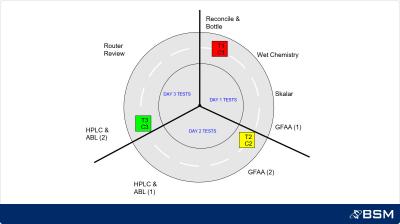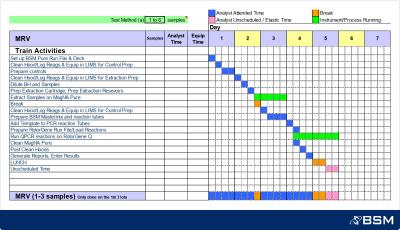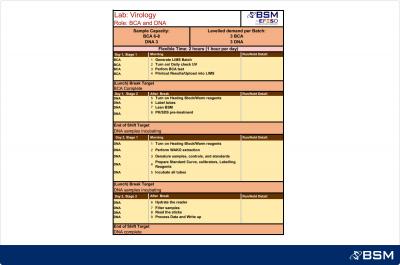The objective of Lean is to maximize customer value by minimizing all wasteful practices. In most Labs, the 'waste' associated with volatile overall and individual analyst workloads is by far the largest. Levelling workloads and introducing flow and standard work will deliver significantly greater benefits than tackling the other (more obvious) wastes on their own.
The detail of a Lean solution can and should vary from Lab to Lab. Every Lab is a unique combination of workload, sample types, equipment and people, but there are common solution themes that apply in all labs. These include:
Levelling and Flow
In labs (and elsewhere) there is a link between levelling and flow. You cannot flow samples through a lab unless the short interval workload is level and you generally can’t level volatile workloads unless you flow the samples.
The simplest levelling strategy is to create the ability to process samples at the 'levelled demand rate' quickly (via flow). We achieve this by developing repeating sequences of testing that move the samples through all the required tests and reviews quickly. This reduces the 'throughput' time and incoming samples can then be held in a 'levelling queue' at the start of the process.
While in the Queue, samples can be prioritised or re-prioritised according to customer requirement using a system of “must start dates". But when released into the lab as part of a level daily workload, they are processed in strict FIFO order.
To make this approach simple to manage and control we develop Hijunka devices which we call 'rhythm wheels'. For higher levels of volatility' we use a somewhat different Hijunka device which we call 'Test Trains'.
These repeating test sequences are carefully designed to meet the overall laboratory workload and consistently achieve the lead times required by the business.
Rhythm Wheels and Trains
A 'rhythm wheel' is fixed repeating sequence of tests that is designed to meet 'levelled demand', and achieve consistent, repeatable 'through-put' times while balancing daily workloads.
The sequence repeats at a fixed internal which for individual rhythm wheels can vary from hours to weeks. Individual test runs are placed in the sequence in order to balance daily workloads and avoid equipment conflicts etc.
Rhythm Wheels & Trains - What They Do
- They allow recovery of much of the volatility losses (See Key Lean Lab Concepts).
- Because they control the workload and the mix they allow the design of well balanced productive roles that make good use of people’s time. - i.e. “Solve the problem once and keep using the solution”.
- They eliminate the need for elaborate short term planning and scheduling processes.
- They facilitate fixed repeating sequences of operation and ‘economies of repetition’.
Note: There are many alternative levelling strategies and Hijunka devices available. Every lab is a unique combination of workload, volatility, lead-time, equipment and test types. While following the same basic principles, the exact nature and detail of solutions will vary significantly from lab to lab. (See Key Lean Lab Concepts).
Standard Work
Some people are naturally good 'time and task' managers and will organise and sequence their work in a logical and productive manner. However many people are not. We use a Standard Work approach to develop repeatable analyst roles (possible because we are controlling the workload and the mix). This improves the operation of the rhythm wheel or train and reduces errors and failures. Also because Standard Work combines tasks and uses people’s time well, it also delivers a significant productivity gain in itself.
- Design standard roles that make good use of resources
- Identify manned and unmanned tasks and define a sequence and combination of tasks that utilise available time effectively - Leverage your good 'time and task managers' and SME’s (Subject Matter Experts)
- Map the combination and sequencing of tasks based on those people who are productive because they organise their work well (not because they move fast) - Do a paper design with a team, then trial, refine and deploy
- Involve analysts in an iterative process to design productive roles which meet the requirements of your train or rhythm wheel
Eliminating other Wastes
In every Lab there are wasteful practices. These can literally be anything but there are some common wastes that are found in most labs. (See What we find in Labs). Waste is relatively easy to see and understand and there are tools like Value Stream Mapping which support waste reduction or elimination projects.
One of the risks with waste reduction initiatives is that the benefits are often not collated and converted into real overall lab performance improvement. For example, reducing or eliminating data entry might give every analyst back one hour per day, but in the absence of levelling and standard work, this is unlikely to result in reduced costs, higher productivity or reduced lead-times.
Documentation
A lot of laboratory waste is centred around documentation. In a manual documentation process, considerable time and effort is required to both document and review test data. In addition, there is often a small ‘cottage industry’ based on documentation error correction.
The required effort can be significantly reduced by re-engineering manual test record documents and the review process itself or (with considerably more investment) by using an ELN (Electronic Lab Notebook) or other software-based solution.
For manual documentation BSM often uses a solution based on 'Real Time' review of significantly re-engineered documents (which reduce both documentation effort and the risk of error).




